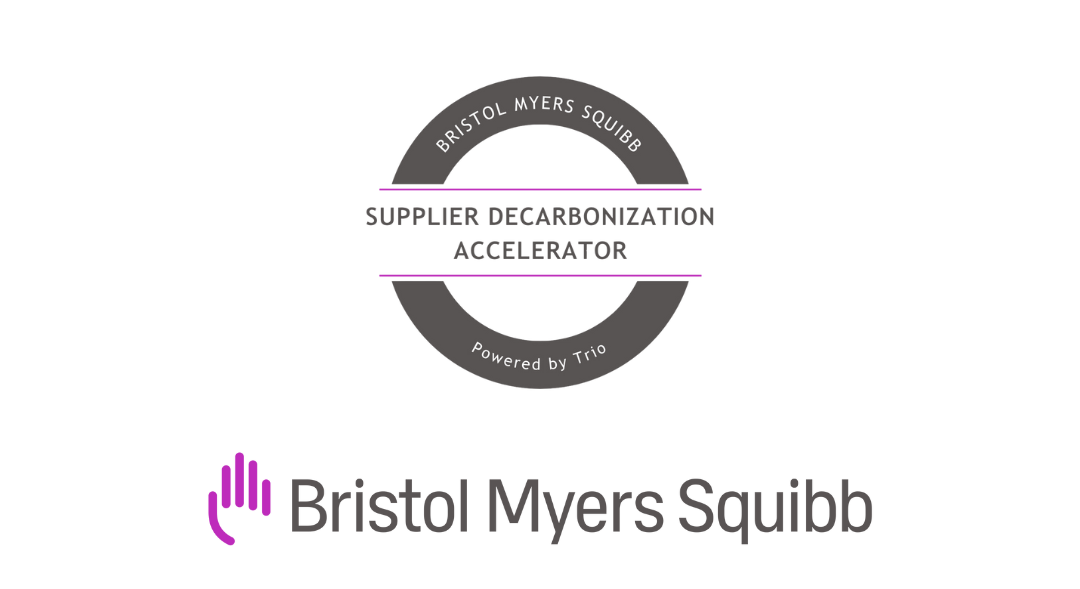Bristol Myers Squibb Supplier Decarbonization Accelerator Resource Library
Bristol Myers Squibb is a founding sponsor company in the My Green Lab Converge program, which aspires for the pharmaceutical sector to lead the world on supply chain engagement with a thriving value of sustainability across every supplier lab and every scientist.
Bristol Myers Squibb has joined dozens of other industry-leading pharma companies to sponsor Energize, a program facilitated by Schneider Electric to support education about renewable energy adoption and contracting.
Bristol Myers Squibb is a founding member of Activate, a collaboration between global pharmaceutical companies and active pharmaceutical ingredient supply chains (APIs) to decarbonize this environmentally intensive part of the pharmaceutical value chain.
PSCI creates and promotes responsible business practices throughout the pharmaceutical supply chain and has developed guides and frameworks to support pharmaceutical suppliers on their decarbonization journeys. Please see below for more PSCI information and resources.
You can’t set GHG reduction targets until you have a comprehensive understanding of what your GHG emissions are. If you are new to GHG accounting, it is important to start to gain an understanding of what your emissions profile looks like by calculating baseline emissions. The Greenhouse Gas Protocol (GHGP) has developed internationally recognized standards and frameworks to account for your GHG emissions. Its frameworks provide guidance and best practices for measuring and managing emissions. The GHGP emphasizes five core principles when it comes to GHG accounting: relevance, completeness, consistency, transparency and accuracy.
Key resources and tools for measuring your GHG footprint are outlined on the right, we encourage suppliers to review the content and reach out to the Trio team to schedule a complimentary office hours session if you have any questions or are seeking support on next steps.
The GHG Protocol Corporate Accounting and Reporting Standard provides requirements and guidance for companies and other organizations preparing a GHG emissions inventory. Its purpose is to:
- Help companies prepare a GHG inventory
- Simplify and reduce the costs of compiling a GHG inventory
- Provide business with information that can be used to build an effective strategy to reduce GHG emissions
- Increase consistency and transparency in GHG accounting and reporting
Calculating emissions is a multi-step process. An accurate and useful inventory can only be developed after careful attention to quality control issues and to the activity data required. Suppliers should consult GHG Protocol’s Corporate Accounting and Reporting Standard for guidance on the entire inventory development process.
Emissions are broken out into scopes 1, 2, and 3. These scopes can be thought of as categories of emissions, with some occurring under the company’s direct control and others occurring within the supply chain or elsewhere outside of an organization’s direct control. Each scope is measured and calculated differently:
Scope 1 - GHG emissions directly from your company. Examples include emissions from combustion onsite like furnaces and boilers, emissions from vehicle exhaust, process emissions, and emissions from equipment leaks.
Scope 2 - Indirect GHG emissions from the generation of purchased energy that is consumed in sources owned or controlled by the organization (electricity, steam, heating, and cooling).
Scope 3 - Indirect GHG emissions from all other sources not owned or controlled by the organization but occur in the value chain, including both upstream and downstream emissions.
To learn more about GHG accounting frameworks, please visit the Greenhouse Gas Protocol.
The GHG Protocol has developed a suite of tools to enable companies to develop comprehensive and reliable inventories of their GHG emissions. Each tool reflects best-practice methods that have been extensively tested by industry experts. Many tools are accompanied by a PDF guidance document, which provides step-by-step guidance on the use of a tool and should be consulted first. Most companies will need to apply more than one tool to cover their emissions. There are several different tools including:
- Cross-sector tools: Applicable to many industries and businesses regardless of sector
- Sector-specific tools: Principally designed for the specific sector or industry listed, though they may be applicable to other situations.
To find out more about the tools available to support you in calculating you GHG footprint, please visit the Greenhouse Gas Protocol.
This technical guide serves as a resource for suppliers who are embarking on their target-setting journeys. It includes information on BMS’s ask to suppliers, why emissions reductions target setting is important, what to consider when getting started, and how to set and validate science-based targets.
Key resources and tools for setting targets with the Science-Based Targets Initiative (SBTi) are outlined on the right, we encourage suppliers to review the content and reach out to the Trio team to schedule a complimentary office hours session if you have any questions or are seeking support on next steps.
Download Whitepaper
Not sure where to begin with the Science-Based Targets Initiative (SBTi)? This is a high-level guide including a helpful flow chart to determine where to start and if there are supplemental resources and guidance for your sector. It also includes basic steps and criteria for setting near-term and long-term targets. It is a useful overview and shows what to consider for science-based target setting.
The Science Based Target Initiative (SBTi) is a global charity that develops standards, tools and guidance for companies setting emissions reductions targets. Their standards ensure that targets are aligned with reaching net-zero (zero greenhouse gas emissions) by 2050 at the latest. This document is a standard for setting Science Based Targets as a corporation. It has detailed information on near-term and long-term science-based targets, mitigation pathways, the target setting process, SBTi target criteria, and has other useful supplementary guidance.
The Corporate Near-Term tool is a downloadable Excel tool from SBTi that enables corporations to model their near-term emissions reduction targets. The tool ensures the targets are in line with SBTi approved criteria and uses SBTi approved methods. You can input your company's emissions data, target year, and target setting method. The tool will analyze the data and provide visualizations, summaries, and models of your emissions reductions target data for review.
SBTi Services is a subsidiary of Science Based Targets initiative. SBTi Services checks, assesses, and validates emissions reductions targets. This document contains an overview of the target validation process including how to commit, how to submit, and how targets are screened and assessed. It includes details on each step, what to expect from the target validation process, and describes how targets are assessed.
BMS is a member of PSCI, a group of leading pharmaceutical companies that work together to promote and execute responsible pharmaceutical supply chain practices. Together they create and set high standards for suppliers with the goal of promoting responsible value chain management and improving business practices across the pharmaceutical industry.
Suppliers can adopt PSCI principles into their business, utilize training and workshops, engage with peers, and pursue continuous improvement by aligning with the evolving industry.
To the right are some of PSCI's key resources and documents.
PSCI has key principles that set expectations for suppliers and represent the foundation on which they builds their resources, tools, and materials. This document outlines each principle and categorizes them under one of five umbrellas; governance and management systems, ethics, human rights, health and safety, and environment.
One of PSCI's Environment Principles - The Climate Change Principle:
"Suppliers shall monitor and reduce their GHG emissions and support their suppliers to do the same"
Meeting PSCI's Environment Principles includes reducing GHG emissions, or decarbonizing. To support companies on this journey, PSCI published this decarbonization playbook for the pharmaceutical industry. It details possible emission reduction initiatives across multiple impact areas in the drug development lifecycle. It also dives into the unique challenges for the pharmaceutical industry, breaks down twenty-four emissions reduction initiative options, and explores the organizational capabilities that can impact progress.
To meet emission reduction targets and meaningfully decarbonize, companies must address their scope 3 emissions, which include emissions generated by their suppliers. PSCI created the maturity model to act as a framework that supports supplier decarbonization. It includes four levels that suppliers can be categorized as in their decarbonization journey and provides expectations and actions for them to explore throughout each level to grow and advance.
This resource provides guidance on assessing upstream and downstream GHG emissions within pharmaceutical value chains. It outlines the steps involved in determining inventory of scope 3 emissions and goes through calculation methods for each of the fifteen different scope 3 categories of emissions.
Webinar: Scaling Supplier Progress
Watch this recording where we present the roadmap to target setting designed to give suppliers discrete next steps to progress toward BMS' decarbonization target requirements. We introduce our vision for what's next to help suppliers track progress, identify upcoming milestones, and take relevant next steps on their journey. To bring these ideas to life, we spotlight a few suppliers actively advancing their climate strategies, sharing insights, challenges, and real-world progress. Whether you’re just getting started or are deep into implementation, this session will offer clarity, connection, and momentum to keep moving forward together.
Webinar: Developing a Decarbonization Strategy
Watch this recording where we explore the key levers available to suppliers for emissions reduction, including energy efficiency, electrification, renewable energy procurement, and scope 3 strategies.
Our presentation focuses on the resources required to implement each lever and examine why certain strategies may be more suitable for different suppliers and use cases. You will gain valuable guidance on best practices for initiating your decarbonization efforts and learn how to align your approach with the Science-Based Targets criteria.
Webinar: Setting Climate Targets
Watch this recording, where we focus on how suppliers can effectively set Science-Based Targets to drive meaningful decarbonization within their organizations. In this webinar, we walk you through the essential steps, tools, and best practices for setting ambitious yet achievable greenhouse gas reduction targets in alignment with the Science-Based Targets Initiative (SBTi) criteria.
Webinar: Measuring and Understanding Your Emissions
Watch this recording of the informative webinar focused on understanding your greenhouse gas (GHG) footprint, a critical first step for taking climate action. This session will focus on foundational concepts and methodologies for accurately measuring GHG emissions and tips for ensuring reliable data collection and reporting.
Webinar: Building the Business Case for Climate Action
Watch this recording to learn about the tools necessary to sell the internal business case for climate action. The recording explores how corporate sustainability is not only an ethical imperative but also a strategic business decision that can enhance operational efficiency and drive long-term profitability.
BMS Supplier Decarbonization Accelerator Kickoff Event
Watch this recording of the BMS Supplier Decarbonization Accelerator Kickoff Event, where we unveiled an exciting new initiative designed to empower our suppliers in the journey toward net zero. Learn more about BMS’s goals and supplier expectations as well as how the Supplier Decarbonization Accelerator is crafted to provide you with the tools, resources, and tailored support needed to make progress on your sustainability journey.

Visit the main program website to learn more and register for upcoming events.

Begin your decarbonization journey by filling out our interest form or emailing us at BMSDecarbAccelerator@TrioAdvisory.com. Based on your needs and interests, we’ll recommend the most appropriate next step, whether that’s a personalized 1:1 consulting session during office hours or access to curated educational resources such as recorded webinars and learning materials.
